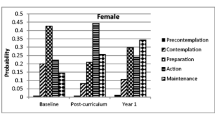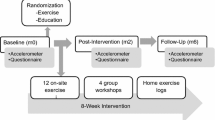Abstract
The transtheoretical model's (TTM's) ability to predict physical activity stage transitions that incorporates all social-cognitive constructs from the original model has not been conducted among adults with diabetes. The purpose of this study was to test the capacity of the TTM for predicting physical activity stage transitions among adults (≥18 years of age) with type 1 (N = 517) or type 2 (N = 1,157) diabetes over 6 months. Participants were identified by a random-digit dialing telephone protocol through the Alberta Diabetes Registry. Assessments of TTM's stage of physical activity behavior change, self-efficacy, pros and cons, cognitive Processes of Change, and behavioral Processes of Change at baseline (time 1) and 6 months (time 2) were assessed by questionnaire. Over this time period, participants were categorized as having regressed (moved back at least one stage), remained (no stage change), or progressed (moved forward at least one stage). Baseline TTM constructs were analyzed for their ability to predict transition over 6 months. Moderate support for the TTM constructs in predicting physical activity stage transitions was found. Self-efficacy, pros, and behavioral Processes of Change hold relatively strong predictive power for stage progression over 6 months, with very few differences found between the types 1 and 2 diabetes groups. The capacity of the model in predicting stage transition is partially supported. When promoting physical activity among adults with diabetes, targeting self-efficacy, pros, and cognitive Processes of Change may favorably support stage transition in the pre-action stages, while strategies to enhance the behavioral Processes of Change may be appropriate for the Action and Maintenance stages.
Similar content being viewed by others
References
Hays LM, Clark DO. Correlates of physical activity in a sample of older adults with type 2 diabetes. Diab Care. 1999;22(5):706-712.
Lin EH, Katon W, Von Korff M, et al. Relationship of depression and diabetes self-care, medication adherence, and preventive care. Diab Care. 2004;27(9):2154-2160.
Morrato EH, Hill JO, Wyatt HR, Ghushchyan V, Sullivan PW. Physical activity in U.S. adults with diabetes and at risk for developing diabetes, 2003. Diab Care. 2007;30(2):203-209.
Nelson KM, Reiber G, Boyko EJ. Diet and exercise among adults with type 2 diabetes: Findings from the third national health and nutrition examination survey (NHANES III). Diab Care. 2002;25(10):1722-1728.
Nothwehr F, Stump T. Health-promoting behaviors among adults with type 2 diabetes: Findings from the health and retirement study. Prev Med. 2000;30:407-414.
Plotnikoff RC, Taylor LM, Wilson PM, et al. Factors associated with physical activity in Canadian adults with diabetes. Med Sci Sports Exerc. 2006;38(8):1-9.
Plotnikoff RC. Physical activity in the management of diabetes: Population-based issues and approaches. Can J Diabetes. 2006;30:52-62.
Rathmann W, Gianni G. Global prevalence of diabetes: Estimates for the year 2000 and projections for 2030. Response to Wild et al. Diabetes Care. 2004;27(10):2568-2569.
Baranowski T. Why combine diet and physical activity in the same international research society? Int J Behav Nutr Phys Act. 2004;1(1):2.
Michie S, Abraham C. Interventions to change health behaviours: Evidence-based or evidence-inspired? Psychol Health. 2004;19(1):29-49.
Rothman AJ. Is there nothing more practical than a good theory?: Why innovations and advances in health behavior change will arise if interventions are used to test and refine theory. Int J Behav Nutr Phys Act. 2004;1(11):1-7.
Sutton S. Stage theories of health behaviour. In: Conner M, Norman PC, eds. Predicting Health Behaviour. Maidenhead: Open University Press; 2005:223-275.
Kreuter MW, Holt CL. How do people process health information? Applications in an age of individualized communication. Curr Dir Psychol Sci. 2001;10(6):206-209.
Weinstein ND, Rothman AJ, Sutton SR. Stage theories of health behavior: Conceptual and methodological issues. Health Psychol. 1998;17(3):290-299.
Prochaska JO, DiClemente CC, Norcross JC. In search of how people change: Applications to addictive behaviors. Am Psychol. 1992;47(9):1102-1114.
Prochaska JO, DiClemente CC. Stages and processes of self-change of smoking: Toward an integrative model of change. J Consult Clin Psychol. 1983;51(3):390-395.
Marshall SJ, Biddle SJH. The transtheoretical model of behavior change: A meta-analysis of applications to physical activity and exercise. Ann Behav Med. 2001;23(4):229-246.
Rosen CS. Is the sequencing of change processes by stage consistent across health problems? A meta-analysis. Health Psychol. 2000;19(6):593-604.
Janis IL, Mann L. Decision making. New York: Free Press; 1977.
Prochaska JO, Velicier WF, Rossi JS, et al. Stages of change and decisional balance for 12 problem behaviors. Health Psychol. 1994;13(1):39-46.
Bandura A. Social foundations of thought and action: A social cognitive theory. Englewood Cliffs: Prentice-Hall; 1986.
Adams J, White M. Why don't stage-based activity promotion interventions work? Health Educ Res. 2005;2:237-243.
Brug J, Conner M, Harré N, Kremers S, McKellar S, Whitelaw S. The Transtheoretical Model and stages of change: A critique: Observations by five commentators on the paper by Adams, J. and White, M. (2004) why don't stage-based activity promotion interventions work? Health Educ Res. 2005;20(2):244-258.
Hutchinson A, Breckon J, Johnston LH. Physical activity behavior change interventions based on the Transtheoretical Model: A systematic review. Health Educ Beh. 2008;36:829-845. doi:10.1177/1090198108318491.
Plotnikoff RC, Hotz SB, Birkett NJ Couneya KS. Exercise and the transtheoretical model: A longitudinal test of a population sample. Prev Med. 2001;33(5):441-452.
Nigg C. Explaining adolescent exercise behavior change: A longitudinal application of the transtheoretical model. Ann Behav Med. 2001;23(1):11-20.
Dallow CB, Anderson J. Using self-efficacy and a transtheoretical model to develop a physical activity intervention for obese women. Am J Health Promot. 2003;17(6):373-381.
Canadian Diabetes Association Clinical Practice Guidelines Expert Committee. Canadian Diabetes Association 2003 Clinical Practice Guidelines for the Prevention and Management of Diabetes in Canada. Can J Diabetes. 2003;27:s1-s140.
Plotnikoff R, Lippke S, Courneya K, Birkett N, Sigal R. Physical activity and social-cognitive theory: A test in a population sample of adults with type 1 or type 2 diabetes. Appl Psychol: An International Review. 2008;57(4):628-643.
Plotnikoff RC, Lippke S, Courneya K, Birkett N, Sigal R. Physical activity and diabetes: An application of the theory of planned behavior to explain physical activity among type 1 and type 2 diabetes in an adult population sample. Psychol Health. 2010;25(1):7-23.
Plotnikoff RC, Lippke S, Trinh L, Courneya KS, Birkett N, Sigal R. Protection Motivation Theory and the prediction of physical activity among adults with type 1 or type 2 diabetes in a large population sample. Br J Health Psychol. 2009; doi:10.1348/135910709X478826). Advance Access: November 13, 2009.
Statistics Canada. Census 2001 - 2B. Ottawa, Ontario: Health Canada; 2001:1-32.
Plotnikoff RC, Brez S, Brunet S. Are exercise social-cognitive factors and behaviours different for adults with diabetes? A randomized community sample. Psychol Health Med. 2003;8(4):465-471.
Plotnikoff RC, Brez S, Hotz SB. Exercise behavior in a community sample with diabetes: Understanding the determinants of exercise behavioral change. Diab Educ. 2000;26(3):450-459.
Plotnikoff R, Lippke S, Reinbold-Matthews M, et al. Assessing the validity of a stage measure on physical activity in a population-based sample of individuals with type 1 or type 2 diabetes. Meas Phys Educ Exerc Sci. 2007;11(2):73-91.
Health Canada. Handbook for Canada’s physical activity guide to healthy active living. Ottawa, Ontario (Contains a 2-page pullout guide.) Available at: http://www.phac-aspc.gc.ca/pau-uap/fitness/pdf/handbook_eng.pdf. Accessed 10 January 2010.
Plotnikoff RC, Blanchard C, Hotz S, Rhodes R. Validation of the decisional balance scales in the exercise domain from the transtheoretical model: A longitudinal test. Meas Phys Educ Exerc Sci. 2001;5(4):191-206.
Lippke S, Plotnikoff RC. The Protection Motivation Theory within the stages of the Transtheoretical Model—Stage-specific interplay of variables and prediction of stage transitions. Br J Health Psychol. 2009;14(2):211-229.
Prochaska JO, Velicer WF. The transtheorectical model of health behaviour change. Am J Health Promot. 1997;12(1):38-48.
Prochaska JO, Norcross JC, DiClemente CC. Changing for good. New York: Avon; 1996.
McKenna J, Francis C. Exercise contemplators: Unravelling the processes of change. Health Educ. 2003;103(1):41-53.
Wiedemann AU, Lippke S, Reuter T, Schüz B, Ziegelmann JP, Schwarzer R. Prediction of stage transitions in fruit and vegetable intake. Health Educ Res. 2009;24(4):596-607.
Acknowledgements
This study was funded by the Canadian Diabetes Association and the Alberta Heritage Foundation for Medical Research. RCP is supported by a Salary Award from the Canadian Institutes of Health Research (Applied Public Health Chair Program). KSC is supported by the Canadian Research Chair Program.
Author information
Authors and Affiliations
Corresponding author
About this article
Cite this article
Plotnikoff, R.C., Lippke, S., Johnson, S.T. et al. Physical Activity and Stages of Change: A Longitudinal Test in Types 1 and 2 Diabetes Samples. ann. behav. med. 40, 138–149 (2010). https://doi.org/10.1007/s12160-010-9193-5
Published:
Issue Date:
DOI: https://doi.org/10.1007/s12160-010-9193-5




